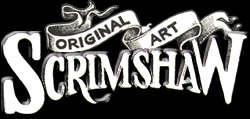|
How
I do it
Click
images to view larger version
|
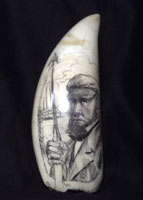 (1 hour 35 min.)
(1 hour 35 min.)
This tooth was supplied by the customer. After deciding
on the subject, I draw a sketch onto the tooth. I use a
Grumbacher GAMMA pencil to put the sketch onto the ivory.
This pencil is the best for drawing on slick surfaces, will
even write on glass. When I get the sketch about where I
want it, I use a spray fixative to protect the drawing until
the main lines are scratched in. Some detail is worked out,
but the sketch is generally pretty loose, only meant as
a guideline for what is to come.
|
|
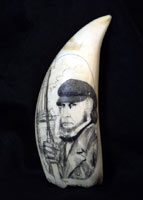 (4 hours 58 min)
(4 hours 58 min)
The first lines scratched are the outlines of the main features
of the design. In this case, the outlines of the main figure,
the border and the horizon line. Then I set in to the real
work, scratching in lines in almost a ‘basket weave’
type of pattern on the man’s cap. Also the eyes, beard,
hair and tie. All these areas will be the darkest areas
of the finished piece. I always work from dark to light,
scratching in the areas that will be the darkest colors
first. I use oil paint instead of the traditional ink. It
is more stable, lightfast and waterproof. |
|
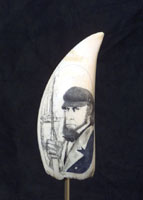 (8 hours 38 min)
(8 hours 38 min)
I decided to make the jacket a DARK blue rather than the
black, which was my first thought. The piece needed a bit
more color. The many tiny lines in the jacket as well as
the continued work in the cap, hair and beard make for monotonous
work in this stage. The fixative is beginning to wear off
the tooth at this point, especially when I add the oil paint
and wipe off the excess with a Q-Tip. The continued filling
and wiping tends to wear the fixative off gradually, which
is good. I’ve found that I usually don’t have
to make a conscious effort to remove it. |
|
 |
 |
 |
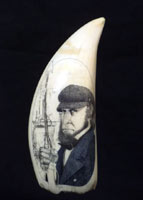 (12 hours 23
min)
(12 hours 23
min)
At this point of work, I have finished the cap, beard and
jacket. Now also, you will see that I have begun to put
in the shadow on his forehead and around the eyes. I almost
always use stipple for flesh. Stipple affords the smoothest
tonal transitions, takes longest to do, and builds up slower
than any other scratching technique. I used a mixture of
burnt sienna and burnt ochre for filling the scratches in
the face. In addition, there is some use of black especially
on the eyes, nostrils and mouth. |
|
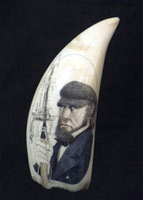 (14 hours 41 min)
(14 hours 41 min)
The main shadows in the face are now shown by stippling the scratches
in the darkest areas. As you stipple, you can change the darkness
of the area by both pressure and closeness of the pattern. I redrew
this pattern of light before I began stippling the face. You must
be careful when you go back in with a pencil at this point. Do not
get the graphite into any scratch marks because that will muddy
up your colors. The face shown here is virtually finished. Basically,
there are only two tones represented in the face here: light and
shadow areas. I could have done more subtle tonal transitions in
the face, but the price would have been dramatically higher as a
result. I also have scratched in part of the harpoon at this point.
<NOTE: one of the most frequently asked questions I get is, “What
if you make a mistake? This is a good example of what can be done
in such a case. Look at the rope trailing around the harpoon. See
where the rope is looped around itself? You can see the lines beneath
the rope so that it looks like the rope is clear? Those lines were
a mistake. It will be scratched out later by removing the black
paint from the wrong scratches and overworked with the right ‘rope’
color.
|
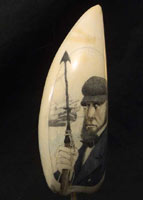 (17 hours 41 min)
(17 hours 41 min)
Now the figure and harpoon
are finished. I decided to make the ship larger than the original
sketch. After redrawing it in pencil, I have begun to fill it
with black. I want the ship to be secondary so it will stay mostly
black paint. I have also begun to delineate the water area between
the hand and the ship.
|
 |
 |
 |
(21 hours 7 min)
Almost finished! More has been done on the water,
the hand, buttons, ship and harpoon. The water is done in a blue/green
mixture. The hand is done in the same way the face was with the
two basic areas of light & shadow. The rope is finished now
(with the mistake covered!) All we lack is the finishing touches
on the ship and the stand for the piece. We’ve also arrived
at a title, “Bent to the Whale”. This is a play on
words; the inclination of the man and the shape of his harpoon.
Most harpoons were bent by the taking of whales. They were tempered
so that they would bend instead of breaking. One of the men aboard
a Whaling Ship was always a blacksmith to care for the iron harpoons,
lances, etc. Notice too, that I have added my signature ‘Garbo’
at the bottom right of the art.
|
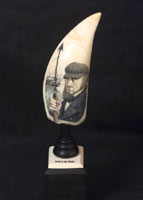 (25 hours 36 min)
(25 hours 36 min)
FINISHED! The base is made of a block of ebony
wood capped with a 1/8” piece of elephant ivory and
a turned finial of ebony. Inserted in the finial is a brass
rod which connects the tooth to the stand. I scratched the
title into the elephant ivory top. Finally, I cut a piece
of leather and attached it to the bottom of the stand so
it will rest easily on the customer’s
desk. Finally, I notify the customer the work is complete.
|
|
| |
|
|
| |
|
|
|
